A Generic Workflow for Achiral SFC Purification of Complex Pharmaceutical Mixtures
LCGC North America
This process can improve efficiency in a drug discovery laboratory.
An effective workflow has been established that uses chiral as well as achiral stationary phases in combination with compound-specific gradient methods for fast mass-directed supercritical fluid chromatography (SFC) purification of complex mixtures. It has been used successfully to purify mixtures that show little or no separation in reversed-phase high performance liquid chromatography (HPLC).
Supercritical fluid chromatography (SFC) has been considered a state-of-the-art chiral separations technique for the past decade (1–5), while recently emerging as a choice technique for achiral separations (6,7). The primary driving force for this operational movement is the commercialization debut of mass-directed preparative units, which adopt similar hardware and software as the widely used reversed-phase high performance liquid chromatography (HPLC) system (8,9). Beyond their normal-phase chromatographic capabilities, SFC systems fulfill the need for speed and efficiency with numerous practical advantages relative to reversed-phase HPLC including higher throughput, shorter cycle times, and lower operating costs because of the "green" nature of these systems that results from lower solvent consumption and waste disposal (10–12).
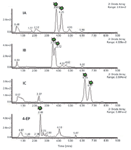
Figure 1: Analytical screening of stationary phases Chiralpak IA, IB, IC, and achiral 4-ethylpyridine. Gradient: 10â60% modifier in 5 min; flow rate: 4 mL/min. Starburst symbol highlights the peaks of interest.
Despite the current expanding application of SFC in the discovery laboratories of the pharmaceutical industry, only a limited number of interesting approaches for difficult achiral SFC purification have been reported (13–15). No standardized methods or generic workflow appear to have been adopted. Experiences at our drug discovery laboratories have shown that the implementation of a generic workflow, with the appropriate combination of the mobile phase and a collection of selected stationary phases, can significantly reduce the turnaround time of purification and thus increase efficiency. For this purpose, a special workflow was developed that consists of an effective and fast-screening protocol using chiral and achiral stationary phases in combination with compound-specific gradient methods for fast mass-directed SFC purification of complex mixtures (16). It has been successfully used for the purification of structurally similar diastereomeric and regioisomeric mixtures that have little or no separation in reversed-phase HPLC. With faster separation, higher sample throughput, less organic solvent usage, and mass-triggered fraction collection, the SFC–mass spectrometry (MS) technique has become a primary purification tool for difficult achiral samples in our laboratories.
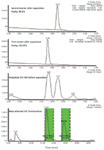
Figure 2: Preparative profile obtained using a Chiralpak IA column (gradient: 40â60% modifier in 18 min; flow rate: 30 mL/min) and QC of purified products.
Experimental Conditions
The analytical and preparative SFC–MS systems used were from Thar Technologies (Pittsburgh, Pennsylvania).
The analytical SFC system consists of a Thar SFC front end with a total flow rate up to 10 mL/min, a Waters ZQ mass detector (Waters Corporation, Milford, Massachusetts) and six columns, including Chiralpak IA, IB, IC (Chiral Technologies Inc., West Chester, Pennsylvania), 4-ethylpyridine (Princeton Chromatography Inc., Cranbury, New Jersey), Chromegabond Pyridine Amide (ES Industries, West Berlin, New Jersey), and CN (Zymor, Inc., Wayne, New Jersey). The system is operated using Masslynx software from Waters.

Table I: Separation factor at analytical level
Rapid SFC analytical screening was performed primarily on chiral stationary phases (CSPs) and occasionally on achiral stationary phases when chiral columns failed to achieve resolution of the analytes. The rationale behind this approach was based on our empirical data generated from compounds purified over the past two years. Polysaccharide-based CSPs (100 mm x 4.6 mm, 5-µm columns) and achiral alkyl bonded stationary phases (150 mm x 4.6 mm, 5-µm columns) were screened in the following order: IA, IB, IC and 4-ethylpyridine, Chromegabond Pyridine Amide, CN. Only polysaccharide-bonded CSP columns were screened because of their high compatibility with a broad range of sample solubilizing solvents (such as dimethyl sulfoxdide [DMSO] and dimethylformamide [DMF]) (3).
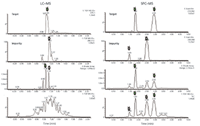
Figure 3: Analytical LC (column: 100 mm x 2.1 mm, 1.7-µm BEH C18; gradient: 5â90% acetonitrile in 1.5 min; flow rate: 0.6 mL/min) and SFC chromatograms of the mixture (columns: 100 mm x 4.6 mm, 5-µm Chiralpak IC; gradient: 10â60% modifier in 5 min; flow rate: 4 mL/min).
The analytical screening was performed with a gradient of 10–60% in 5 min and a modifier of 0.2% isopropylamine in methanol. Because most drug discovery programs produce compounds that are basic or halogenated (or both) in nature, improved peak shape and enhanced loading of compounds may be achieved using amine additives instead of pure modifiers. Based on our experience, 0.2% isopropylamine additive in methanol was identified as the best modifier system in terms of resolution, after screening a variety of amines and different concentrations of isopropylamine (data not shown). Experimental results showed that increased concentrations of isopropylamine did not yield additional improvement of the chromatographic resolution, but instead had a damaging effect on the ionization pattern. The flow rate was 4 mL/min, the back pressure was set at 150 bar, and the column temperature was kept at 40 °C.

Figure 4: Preparative profile obtained using a Chiralpak IC column. Mobile phase: isocratic, 25% modifier; run time: 16 min; flow rate: 30 mL/min.
Preparative SFC–MS runs were performed on a Thar SFC–MS Prep 30 system; a fully integrated MS directed preparative SFC unit, equipped with a Waters 3100 mass detector, a Waters 2757 sample managing module for open bed fraction collection, and a Thar SFC front end with a total flow rate of up to 30 mL/min, using various 250 mm x 21 mm preparative columns. Samples injected into the system were dissolved in DMSO or DMF. A compound-specific preparative SFC gradient was derived from the retention time and elution profile of the compound in the analytical run (3). The flow rate used was 30 mL/min and additional chromatographic conditions used in the preparative purification included a back pressure of 150 bar, a column temperature of 40 °C, and 0.2% isopropylamine in methanol as modifier. Injection volumes ranged from 100 to 500 µL with an initial crude sample concentration of 50–70 mg/mL. Mixtures used in this study were all synthesized and submitted to purification by our internal medicinal chemists.
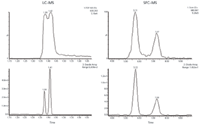
Figure 5: Analytical LC (column: 100 mm x 2.1 mm, 1.7-µ1m BEH C18; mobile phase A: acetonitrile; mobile phase B: 0.01% formic acid in water; gradient: 10â90% A in 1.5 min; flow rate: 0.6 mL/min) and SFC chromatograms of the mixture (columns: 150 mm à 4.6 mm, 5-µm Chromegabond Pyridyl Amide; modifier: 10% of 0.2% isopropylamine in methanol; flow rate: 4 mL/min).
Results and Discussion
Case Study 1: The first example involved the purification and separation of a diastereomeric mixture. The differences in selectivity of the stationary phases are highlighted in Figure 1. For this specific mixture, the Chiralpak IA column demonstrated the best separation of the diastereomers, in addition to other components, in the crude mixture. Although the Chiralpak IC column also showed suitable separation of all constituents, the Chiralpak IA column was chosen for preparative purification based on its higher column loading and better chromatographic performance. A compound-specific preparative SFC gradient of 40–60% in 4 min and flow rate of 30 mL/min was subsequently applied and successfully isolated the desired compounds from the impurities (Figure 2). The injection volume used here was 200 µL with a sample concentration of 50 mg/mL in DMSO. Following the purification, the overall purity of the collected product fractions was confirmed by performing an SFC–MS analysis. The purification was successful in isolating the two isomers with purities by UV254 of ~99.99% and 98.66%, respectively.
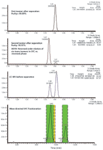
Figure 6: SFC preparative profile obtained using a Chromegabond Pyridyl Amide column (mobile phase: isocratic, 25% modifier; run time: 14 min; flow rate: 30 mL/min) and QC of products using LC.
Case Study 2: The second example involved the purification and separation of a complex four-component mixture of regioisomeric pairs with their corresponding methylated impurities (+14 Da). The mixture was poorly resolved via LC–MS. However, an analytical SFC–MS screening workflow identified Chiralpak IC as a feasible stationary phase for the separation of the mixture (Figure 3, symbol highlights the peaks of interest). Mass-directed preparative SFC purification under 25% isocratic conditions successfully isolated the two regioisomers, as well as their methylated by-products (Figure 4). The injection volume was 100 µL with a sample concentration of 200 mg/mL in DMSO.
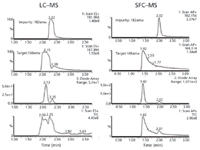
Figure 7: Analytical LC and SFC chromatograms of the mixture on Chiralpak IA. LC column: 50 mm X 4.6 mm, 3.5-µm XBridge C18; gradient: 5â90% acetonitrile in 2 min; flow rate: 1.0 mL/min. SFC column: Chiralpak IA; gradient: 10â60% modifier in 5 min; flow rate: 4 mL/min.
Case Study 3: The third example involved the purification and separation of a cis/trans-isomeric mixture. The differences in separation factor on LC–MS versus SFC–MS screening phases are highlighted in Table I. For this specific sample, the Chromegabond Pyridyl Amide column demonstrated the best separation conditions for resolving the mixture (Figure 5). The performance of preparative SFC–MS separation with a 150 mm x 21 mm Chromegabond Pyridyl Amide column under 25% isocratic conditions with a flow rate of 30 mL/min and a back pressure of 150 bar is shown in Figure 6. Following the purification, the overall purity of the collected product fractions was confirmed by LC–MS analysis. The successfully isolated trans-isomer had a purity of ~99.99%, while the cis-isomer had a purity of 94.16%. It is important to note from experimental results that the cis/trans-isomers displayed reversed elution order on achiral columns in SFC versus reversed-phase HPLC, while the same elution order (data not shown) was observed on chiral columns for both SFC and reversed-phase HPLC (16).
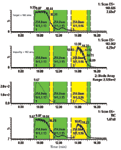
Figure 8: Preparative profile obtained using a Chiralpak IA column. Mobile phase: isocratic, 20% modifier; run time: 18 min; flow rate: 30 mL/min.
Case Study 4: The fourth example involved the separation of a very polar product mixed with its methylated impurity (+14 Da), which tends to be coeluted in reversed-phase HPLC. The initial desired product purity was approximately 84.66% from a typical mass-directed HPLC purification. A higher purity of 99.8% was needed for in-vivo pharmacological evaluations and both target and impurity needed to be isolated and characterized. For this specific crude mixture, the Chiralpak IA column demonstrated the highest resolving power (Figure 7). Mass-directed preparative SFC purification performed under the isocratic conditions (20% modifier in 18 min, flow rate 30 mL/min) successfully isolated the desired compound from its methylated impurity (Figure 8). The final recovery for the desired product was 85% with a purity of 99.9% by HPLC (Figure 9). The injection volume used here was 400 µL with the crude sample concentration of ~70 mg/mL.
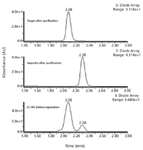
Figure 9: HPLC chromatogram of the mixture and QC of the purified products. Column: 50 mm X 4.6 mm, 3.5-µm XBridge C18; gradient 5â90% acetonitrile in 2 min; flow rate: 1.0 mL/min.
Conclusions
Based on our experiences, the SFC gradient screening strategy delivers fast method development for the resolution of complex achiral mixtures, which enables their translation to preparative SFC. When comparing chiral to achiral columns, the chiral columns provide a higher success rate in terms of recovery and purity of the purified products from isomeric purification, making them more efficient and therefore offsetting associated higher costs. Those benefits have been confirmed for all isomers purified by our laboratory over the past two years.
To the best of our knowledge, this is the first effective workflow that combines short chiral stationary phases with fast gradients for rapid SFC purification of pharmaceutical achiral compounds. It should be applicable to the purification of a wide number of pharmaceutically relevant compounds.
References
(1) C. White, J. Chromatogr. A 1074, 163–173 (2005).
(2) D. Mangelings and Y. Vander Heyden, J. Sep. Sci. 31, 1252–1273 (2008).
(3) G. Felix, A. Berthod, P. Piras, and C. Roussel, Separation and Purification Reviews 37 (3), 229–301 (2008).
(4) D. Wu and L. Leith, Am. Pharm. Rev. 10, 84–87 (2007).
(5) L. Taylor, J. of Supercritical Fluids 47, 566–573 (2009).
(6) R.T. McClain, A. Dudkina, J. Barrow, G. Hartman, and C. J. Welch, J. Liquid Chrom. & Rel. Techn. 32(4), 483–499 (2009).
(7) L. Miller, and M. Potter, J. Chromatogr. B 875(1), 230–236 (2008).
(8) V. Lazarescu, Y. Li, M.J. Mulvihill, and L. Ma, poster presented to the 2nd International Conference on Packed-Column SFC in Zurich, Switzerland, October 1–2 (2008).
(9) C. Aurigemma, and W. Farrell, J. Chromatogr. A in press.
(10) T. Berger, K. Fogleman, T. Staats, P. Bente, I. Crocket, W. Farrell, and M. Osonubi, J. Biochem. Biophys. Meth. 43, 87–111 (2000).
(11) M. Ventura, W. Farrell, C. Aurigemma, K. Tivel, M. Greig, J. Wheatley, A. Yanovskya, K.E. Milgram, D. Dalesandro, R. DeGuzmana, P. Tran, L. Nguyena, L. Chunga, O. Grona, and C. A. Koch, J. Chromatogr. A 1036, 7–13 (2004).
(12) W.C. Ripka, G. Barker, and J. Krakover, Drug Discov. Today 6, 471 (2001).
(13) T.Q. Yan, J. Bradow, S.P. Chang, R. Depianta, and L. Philippe, LCGC North America 27(4), 340 (2009).
(14) F. Mannerino, Z. Ali, and J. Wheeler, presentation to the 4th International Conference on Packed-Column SFC in Stockholm, Sweden, September 15–16 (2010).
(15) V. Lazarescu, M.J. Mulvihill, and L. Ma, poster presented to the 3rd International Conference on Packed-Column SFC in Philadelphia, Pennsylvania, July 22–23 (2009).
(16) Part of this work has been presented in the 4th International Conference on Packed-Column SFC in Stockholm, Sweden, September 15–16 (2010).
Vivi Lazarescu, Mark J. Mulvihill, and Lifu Ma are with the Department of Cancer Chemistry at OSI Pharmaceuticals in Farmingdale, New York.

Polysorbate Quantification and Degradation Analysis via LC and Charged Aerosol Detection
April 9th 2025Scientists from ThermoFisher Scientific published a review article in the Journal of Chromatography A that provided an overview of HPLC analysis using charged aerosol detection can help with polysorbate quantification.
Removing Double-Stranded RNA Impurities Using Chromatography
April 8th 2025Researchers from Agency for Science, Technology and Research in Singapore recently published a review article exploring how chromatography can be used to remove double-stranded RNA impurities during mRNA therapeutics production.













